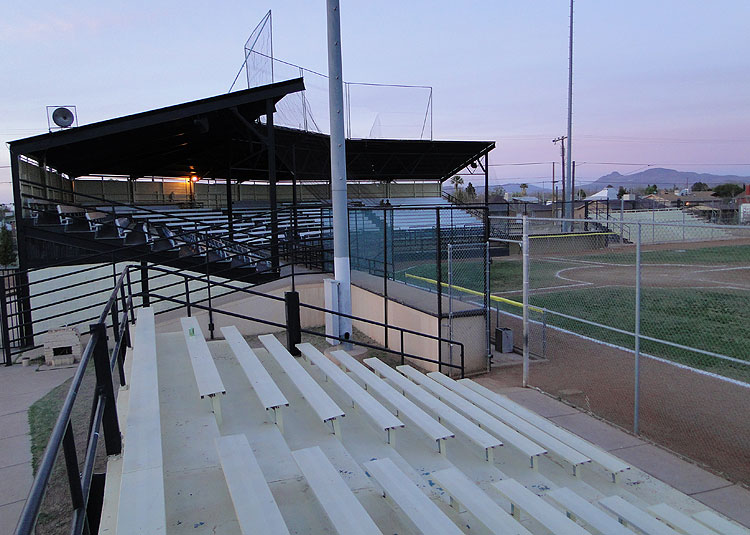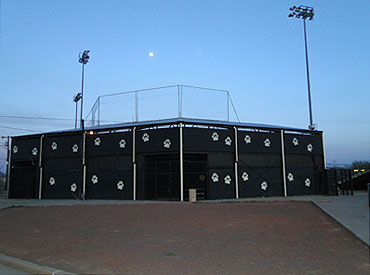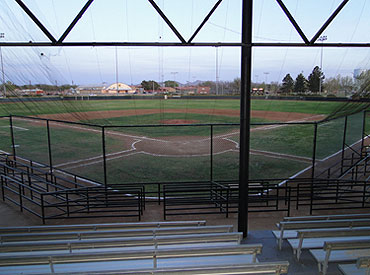
|
Just about two miles north of the Mexican border stands Copper King Stadium. Located in the Arizona city of Douglas, it opened on May 2, 1948, although its playing field has been around since at least 1913. Owned by the city, it's mainly used for high school baseball games now. The Douglas High School football stadium is adjacent to the ballpark and a big bank of the football stadium's sideline bleachers are along the ballpark's right field line.
A classic looking park for sure, Copper King Stadium acquired its name in 1949. That year, and for a handful after, the minor league team that played here was called the Copper Kings. Pro baseball hasn't been played here in a while though, so the Douglas High Bulldogs are now the prime tenant in the ballpark that features a covered grandstand and two sets of permanent bleachers near it. Made of hard plastic, both baseline bleacher sets have 10 backless rows. The grandstand also has 10 rows of bleachers, but they have backs and their base is made of corrugated sheet metal. In front of the grandstand's bleachers is a concrete cross aisle and it separates the bleachers from three rows of railed seating that lack any permanent seats. Before the advent of the modern fixed stadium-style chair, folding chairs were often used as box seats and placed in rows lined with hand/guard rails. Such is still the set up at Copper King Stadium, although chairs aren't guaranteed to be there. So don't be surprised to see bare concrete surrounded by rails where the box seats should be. Fans enter the grandstand on either of its sides. Because you enter elsewhere, the facade behind home plate isn't visible unless you venture behind the grandstand to see it. But it's the least charming part of the place, notable only for a gate that can't be used by any fans. The mountain ranges in the distance make for a nice natural backdrop and I think it's nice that the old ballpark still maintains the name of the city's long gone minor league team. Aside from that, you'll find no mention of pro baseball's past here. It's all Bulldogs, and their successes, including seven state championships, are listed on the outfield wall. Built for a minor league team, Copper King Stadium is bigger and better than is needed for high school baseball. But copper is no longer king in the area -- the local mines having been mined of much of it forced the last smelter to close in 1987 -- and pro baseball, much like the once thriving copper industry, is unlikely to ever be revived in Douglas, where a neat little ballpark has been through the boom and bust times to continue to serve its purpose quite well, even if for a level other than what was originally intended. Location and ParkingCopper King Stadium is found in the "Premier Southwestern Border Community," which is written on one of two water towers visible beyond right field. Directly behind right field is a paved parking lot. Plenty more parking is found behind left-center field. The ballpark stands side by side with Armando de Lucas Stadium, the artificially-turfed Douglas High School football field. The high school itself is within eyeshot of the ballpark, as are the Chiricahua Mountains. Numerous homes hem in the ballpark on its third base side. Douglas shares a border with Agua Prieta, a city in the Mexican state of Sonora that has roughly four times the population of Douglas. The border crossing is just 2.8 miles from Copper King Stadium.
HistoryAlthough the current stadium dates to 1948, the playing field has been around much longer than that. The first time it was believed to be used for a professional game was on November 6, 1913, when the New York Giants and Chicago White Sox made a stop in Douglas as part of their famous ’Round the World Tour, which took the two major league teams to much farther away places than Arizona, like Australia and Japan. The game in Douglas was #19 in the American leg of the tour and the Giants were winners with ease, 14-5. The first minor league team to play in Douglas, called the Miners, did so on the field in 1915 as a member of the short-lived Rio Grande Association. Many independent/outlaw league and semi-pro teams followed. Members of the banned "Black Sox" played for the Douglas Blues in the mid-1920s. Chick Gandil, Buck Weaver and Lefty Williams all called what was informally referred to as the Douglas Diamond or Douglas Field their home ballpark. Because of the presence of players who had been banned from organized ball, the independent leagues of long ago were often known as the outlaw leagues. In 1948, the current stadium structure was built. It was to debut in late April, but construction wasn't finished in time for its originally scheduled opener, a game that was moved to Bisbee, the nearest town (25 miles) in the United States to Douglas. The two cities had long been partners in the copper business -- it was mined in Bisbee and smelted in Douglas -- and they essentially established a baseball co-op for the aptly named Copper Kings, using the hyphenated Bisbee-Douglas during the team's dual home ballpark existence, which covered the first eight seasons that Copper King Stadium was open. After a decade of being a minor league ballpark, Copper King Stadium would never be home to an affiliated team again following the demise of the Arizona-Mexico League in 1958. In the then six-team league's final season, Douglas would finish first in the standings (68-52) but last in home attendance (25,315). In 2003, an attempt to revive the Arizona-Mexico League as an independent one briefly brought pro baseball back to the stadium (and Bisbee's). But the league, which held its Opening Day on May 30 of that year, disbanded just 18 days after it began. The Copper Kings had been scheduled to play 18 home games in Bisbee and Douglas, where admission to the few games that were held was $5 for adults and $2.50 for kids and seniors.

Copper King Stadium Facts & Footnotes
Copper King Stadium Firsts & Finales
| ||||||||||||||||||||||||||||||||






